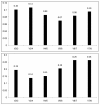Validation of endogenous reference genes for qRT-PCR analysis of human visceral adipose samples
- PMID: 20492695
- PMCID: PMC2886049
- DOI: 10.1186/1471-2199-11-39
Validation of endogenous reference genes for qRT-PCR analysis of human visceral adipose samples
Abstract
Background: Given the epidemic proportions of obesity worldwide and the concurrent prevalence of metabolic syndrome, there is an urgent need for better understanding the underlying mechanisms of metabolic syndrome, in particular, the gene expression differences which may participate in obesity, insulin resistance and the associated series of chronic liver conditions. Real-time PCR (qRT-PCR) is the standard method for studying changes in relative gene expression in different tissues and experimental conditions. However, variations in amount of starting material, enzymatic efficiency and presence of inhibitors can lead to quantification errors. Hence the need for accurate data normalization is vital. Among several known strategies for data normalization, the use of reference genes as an internal control is the most common approach. Recent studies have shown that both obesity and presence of insulin resistance influence an expression of commonly used reference genes in omental fat. In this study we validated candidate reference genes suitable for qRT-PCR profiling experiments using visceral adipose samples from obese and lean individuals.
Results: Cross-validation of expression stability of eight selected reference genes using three popular algorithms, GeNorm, NormFinder and BestKeeper found ACTB and RPII as most stable reference genes.
Conclusions: We recommend ACTB and RPII as stable reference genes most suitable for gene expression studies of human visceral adipose tissue. The use of these genes as a reference pair may further enhance the robustness of qRT-PCR in this model system.
Figures



References
-
- Gomez-Ambrosi J, Catalan V, Diez-Caballero A. Gene expression profile of omental adipose tissue in human obesity. FASEB J. 2003. 03-0591fje. - PubMed
-
- Linder K, Arner P, Flores-Morales A, Tollet-Egnell P, Norstedt G. Differentially expressed genes in visceral or subcutaneous adipose tissue of obese men and women. J Lipid Res. 2004;45:154. 148. - PubMed
Publication types
MeSH terms
Substances
LinkOut - more resources
Full Text Sources
Miscellaneous

